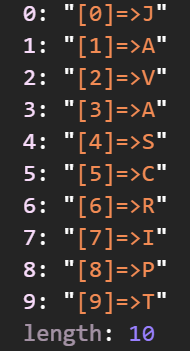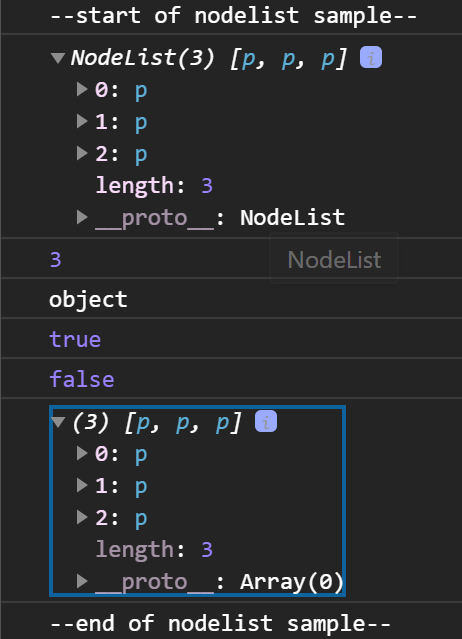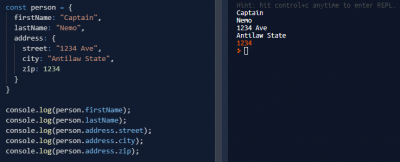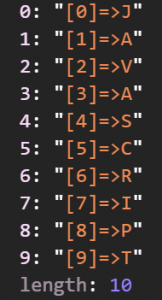介绍
ES6发布后,我发现许多开发人员仍然不知道该Array对象添加的功能。因此,我决定为我们创建这篇文章以传播信息,许多人将从中受益。
背景
本文不是关于JavaScript数组的介绍,而是更多有关检查JavaScript Array对象中新添加的功能的内容。如果您是初学者,建议您进行Google搜索。而且,在我看来,这些附加功能有一个目标,那就是在使用数组时使我们的生活更轻松并提高生产力。最后,如果您对数组有很好的了解,则可以轻松阅读本文。
ECMAScript 6增强型阵列
如前所述,ECMAScript 6(ES6)已向全局Array对象添加了新方法。因此,我们将讨论以下方法:
- Array.from()
- Array.of()
- copyWithin()
- fill()
- find()
- findIndex()
要指出的另一件事情,我们不打算处理这些方法,如entries(),values()和keys()因为我写关于他们在这里。
因此,让我们开始吧。我希望你很兴奋。
Array.from()方法
这是一种从可迭代对象static返回新Array实例的方法。但是,您也可以在第一个参数中传递“ 类似数组的对象 ”。如果您还没有听说过,将在本节中进行讨论。
句法
//syntax //Array.from(arrayLike[, mapFn[, thisArg]]);
参量
- arrayLike –是可迭代对象的引用。
- mapFn –是可选的,并充当称为map-function的回调。
- thisArg–也是可选的,并且是thismap函数内部的值。
例
let result =
Array.from('JavaScript', (val, indx) => `[${indx}]` + "=>" + val.toUpperCase());
console.log(result);
输出量

如您所见,上面的示例很简单(易于理解)。
地图功能
第二个参数(mapFn)(如果提供)是映射回调。调用时,它将每个值从源转换为返回的目标。这类似于Array.prototype.map()方法。现在,为什么不看另一个例子,您不觉得吗?而且,为什么不把它Array.from()放在里面呢Object。为了让我们来看看如何映射回调函数和3 次参数this的行为。
const manager = {
isBadManager: true,
doBadStuff: function (items) {
return Array.from(items, function (val, indx) {
if (this.isBadManager) {
console.log(`${indx + 1}. ${val[0].toUpperCase()}${val.substr(1)}`);
}
}, this);
}
}
/**
* Output:
* 1. That's my idea
* 2. Micromanage
*/
manager.doBadStuff(['that\'s my idea','micromanage']);
同样,这是一个简单易懂的示例。现在,让我们提高一个档次。并且,让我们更多地关注的第一个参数,Array.map()它是类似数组的对象(arrayLike)。
什么是类似数组的对象?
通常,您会在JavaScript中遇到一些看起来像数组的对象,通常称为“ 类似数组的对象 ”。困惑?不用了 它Object的长度属性为非负整数,并且具有一些索引属性。
让我们看下面的例子:
let arrLike1 = {
length: 3,
0: "Jin",
1: "Vincent",
2: "Necesario"
};
而已?是! 现在,让我们看一下如何使用将arrLike1变量转换为实数。ArrayArray.from()
let resultArray2 = Array.from(arrLike1); console.log(resultArray2); //output: ["Jin", "Vincent", "Necesario"]
节点列表
A NodeList是类数组对象的另一个示例。甚至我也挣扎着NodeList。我以为是数组,但不是。NodeList和Arrays 完全不同的东西。
好,那是NodeList什么?甲NodeList目的是集合DOM这是从所提取的节点HTML使用浏览器时文件API诸如querySelector()和/或querySelectorAll()。
现在,我们有一个想法,什么NodeList是,让我们尝试将转换NodeList到Array与使用Array.from()。
<!-- this is the html file -->
<body>
<div>
<p>Hello World 1</p>
<p>Hello World 2</p>
<p>Hello World 3</p>
</div>
</body>
 复制代码
复制代码
/**
* Start of NodeList
* In this code sample we will see what a NodeList is.
* Here are some facts about NodeList.
*
* 1. NodeList aren't arrays.
* 2. NodeList does have a length property
* 3. NodeList does have indexed property
* 4. Therefore, we can conclude that a NodeList does look like
* an Array-like object.
* 5. We can convert NodeList into an array with the use of Array.from()
*/
window.addEventListener("DOMContentLoaded", function (event) {
let elements = document.querySelectorAll("div p");
console.log(elements); //output: NodeList(3) [p, p, p]
//this proves that NodeList does have a length property
console.log(elements.length) //output: 3
console.log(typeof (elements)); //output: object
//this proves that the return of querySelectorAll method is a NodeList
console.log(elements instanceof NodeList); //output: true
//this proves that NodeList aren't arrays
console.log(elements instanceof Array); //output: false
let arrayParagraphs = Array.from(elements);
console.log(arrayParagraphs); //output: Array(3)
});
/**
* End of NodeList
*/
输出量

既然我们熟悉了类似数组的对象,并且已经了解了如何将其转换为真实的数组。我们需要了解的下一个概念是如何避免空插槽。
避免空插槽
空插槽?这些是什么?基本上,当您创建一定长度的Array而不指定每个索引的值时,您将拥有一个空索引,也称为一个空slot。
让我们看下面的例子:
const arrWithEmptySlots = []; arrWithEmptySlots.length = 5; arrWithEmptySlots[0] = "Jin"; //output ["Jin", empty × 4] console.log(arrWithEmptySlots);
输出:

如何检查空插槽?
我们可以使用in运算符来检查数组是否具有键。此外,它返回一个boolean值,false为空时隙,但true用于与值槽,包括undefined值。
让我们看下面的例子:
const arrWithEmptySlots = [];
arrWithEmptySlots.length = 3;
arrWithEmptySlots[0] = undefined;
arrWithEmptySlots[1] = "Jin";
console.log(0 in arrWithEmptySlots);//true
console.log(1 in arrWithEmptySlots);//true
console.log(2 in arrWithEmptySlots);//false
console.log(3 in arrWithEmptySlots);//false
/**
* output:
* 0
* 1
*/
for (let slot in arrWithEmptySlots) {
console.log(slot);
}
这个空插槽与Array.from()方法有什么关系?如果您想生成一个Array初始化为一定长度而没有空插槽的初始化方法,则Array.from()可以解决该问题。
让我们看下面的例子:
const arrayWithEmptySlots_2 = []; arrayWithEmptySlots_2.length = 5; const results = Array.from(arrayWithEmptySlots_2); //output: [undefined, undefined, undefined, undefined, undefined] console.log(results);
在我们进入下一部分之前。然后我们可以得出结论,Array.from()不仅Array从可迭代对象创建新实例。它还接受一个“ 类似数组的对象 ”,该对象将被转换为实数,Array并帮助我们(JavaScript程序员)避免出现空槽。
Array.of()方法
通常,每个人都知道Array构造函数是用来创建Array对象的。此外,Array.of()方法是Array构造方法的替代方法,本节将介绍原因。
句法
//syntax //Array.of([]);
参量
- [] –用于创建数组的元素
让我们看下面的一些例子:
- 创建一个新的Array构造函数并传递多个参数。
let cars = new Array("Toyota", "Mitsubishi", "Nissan", "Honda");
//output: 4
console.log(cars.length);
//output: Toyota Mitsubishi Nissan Honda
console.log(...cars);
let customers = new Array({ name: "Jin" }, { name: "Vincent" }, { name: "Necesario" });
//output: 3
console.log(customers.length);
//output: {name: "Jin"} {name: "Vincent"} {name: "Necesario"}
console.log(...customers);
let luckyNumbers = new Array(23, 29, 32);
//output: 3
console.log(luckyNumbers.length);
//output: 23 29 32
console.log(...luckyNumbers);
到目前为止,一切都很好。让我们转到下一个示例。
- 创建一个新的Array构造函数并传递一个参数。并且,让我们看到故障。
let car = new Array("Toyota");
//still works.
console.log(car);
let customer = new Array({name: "Jin"})
//still works.
console.log(customer);
let luckyNumber = new Array(23);
//glitch
//output: 23
//23 in length????
console.log(luckyNumber.length);
//another glitch
//output: [empty × 23]
console.log(luckyNumber);
小故障?
你发现差异了吗?让我们以luckyNumber变量为例,与变量car和比较,结果不同customer。请记住,当您传递一个带有数字值的参数时。它正在创建一个空数组,其length属性等于该数字,并根据length属性产生空插槽。这是小故障吗?也许是或否。为了避免出现此问题,我们可以使用该Array.of()方法。
让我们看下面的例子:
let superLuckyNumber = Array.of(23); console.log(superLuckyNumber); //output: [23]
因此,Array.of()引入了解决该问题的方法。在评论部分让我知道您的想法。提前致谢。
copyWithin()方法
该copyWithin()方法用于将数组的值序列复制到数组中的其他位置。
句法
//syntax //[].copyWithin(target, start, end);
参量
- target –将元素复制到的索引
- start –可选,这是从其开始复制的索引位置
- end –可选,这是实际结束复制元素的索引
如果起始索引为负,则将其视为数组长度加上起始索引([].length + start)。与结束索引([].length + end)相同。
让我们看下面的例子:
let presidents1 = ["Donald Trump", "Barack Obama", "George Bush", "Bill Clinton"]; let presidents2 = ["George H. W. Bush", "Ronald Reagan", "Jimmy Carter", "General Ford"]; //let's copy to index 0 from index 1 //let's replace Donald Trump with Barack Obama //output: ["Barack Obama", "George Bush", "Bill Clinton", "Bill Clinton"] console.log(presidents1.copyWithin(0, 1)); //let's copy to index 1 from index 2 //, let's replace Ronald Reagan with Jimmy Carter up to 3rd index. //Up to 2nd index only excluding 3rd index. //output: ["George H. W. Bush", "Jimmy Carter", "Jimmy Carter", "General Ford"] console.log(presidents2.copyWithin(1, 2, 3));
简单明了(易于遵循)不是吗?让我们进入下一部分。
fill()方法
该fill方法实际上使用给定填充(全部或部分)从start索引到end索引的Array的所有元素value。此外,startand end索引是可选的;因此,如果未提供它们,则整个Array字段将由您传递的值填充。
句法
//syntax //[].fill(value, start, end);
参量
- value –填充数组的值
- start –可选,是开始索引
- end –可选,是结束索引
如果您已经看到Array构造函数的问题。同样,我们可以使用此方法为数组的所有空插槽设置值。只要目标是初始化具有定义的长度且没有空插槽的数组,就可以执行此操作。
让我们看下面的例子:
let arryLenOf5 = new Array(5).fill(undefined); //output: (5)[undefined, undefined, undefined, undefined, undefined] console.log(arryLenOf5); let arryLenOf3 = new Array(3).fill(0); //output: (3) [0, 0, 0] console.log(arryLenOf3);
让我们再次看一些例子:
//fills the entire array console.log([29, 23, 5, 26, 16, 21].fill(29)); //output: [29, 29, 29, 29, 29, 29] //fills the entire array starting at index 1 console.log([29, 23, 5, 26, 16, 21].fill(30, 1)); //output: [29, 30, 30, 30, 30, 30] //fills the entire array starting at index 1 and ends at 5th position. console.log([29, 23, 5, 26, 16, 21].fill(31, 2, 5)); //output: [29, 23, 31, 31, 31, 21]
如果起始索引为负,则将其视为数组长度加上起始索引([].length + start)。与结束索引([].length + end)相同。
//fills the entire array starting at index ([].length -2) = 4th index. console.log([29, 23, 5, 26, 16, 21].fill(31, -2)); //output: [29, 23, 5, 26, 31, 31] //fills the entire array starting at [1] index ends to ([].length -2) = 4th position. console.log([29, 23, 5, 26, 16, 21].fill(31, 1, -2)); //output: [29, 31, 31, 31, 16, 21]
简单明了(易于遵循)不是吗?让我们进入下一部分。
find()方法
在深入研究该find()方法之前,我们将先退一步。并回答:“它真正解决了什么?”
句法
//syntax //[].find(callback(element,index,array), thisArg);
参量
- callback –对数组中的每个值执行的回调函数
- thisArg–是可选的,Object用作this回调内部
indexOf方法
通常,在中搜索值时首先想到Array的是indexOf() 方法的使用。
让我们看下面的例子:
let nums = [9, 8, 7, 6, 5, 4, 3, 2, 1];
console.log(nums.indexOf(9)); //output: 0;
console.log((nums.indexOf(7) !== -1)); //output: true
console.log((nums.indexOf("9") == 0)); //output: false
console.log((nums.indexOf("Jin Vincent Necesario") !== -1)); //output: false
但是,有时程序员会忘记此方法需要严格的比较。我认为,这就是他们(程序员)使用该some()方法的原因。
some()方法
此方法通过为每个元素调用一个函数回调来起作用,直到一个返回a true 或truthyvalue,最后停止。
好处是您可以控制值的比较,与indexOf() 方法不同。
让我们看下面的例子:
let nums = [9, 8, 7, 6, 5, 4, 3, 2, 1]; console.log(nums.some((num) => num == "9")); //output: true console.log(nums.some((num) => num === "9")); //output: false
现在,关于其缺点some()的方法是,你只能得到boolean价值true或者false,如果配合适当的值被发现,但不是实际的值相匹配的内容。
什么find()方法可以解决?
该find()方法解决了该问题。它的工作原理与some()方法相同,不同之处在于一旦回调返回其值,Array 则返回实际值。因此,find()method返回一个Array元素。仅当满足所提供的条件时,该表达式才会传递给回调函数。否则,返回undefined。
让我们看下面的例子:
let nums = [9, 8, 7, 6, 5, 4, 3, 2, 1]; console.log(nums.find((num) => num == "9")); //output: 9 console.log(nums.find((num) => num === "9"));//output: undefined
为什么没有另一个带有完整参数的示例?
let num = 5;
let nums = [9, 8, 7, 6, 5, 4, 3, 2, 1];
let result = nums.find(function (value, index, array) {
//just shows the values to the console window.
console.log(`The num[${index}] is equal to ${value} ${this}`);
return value === parseInt(this);
}, num);
console.log(result); //output: 5
findIndex()方法
最后,解决的最后方法。这几乎类似于该find()方法。但是,它返回数组元素的索引,而不是元素本身。
句法
//syntax //[].findIndex(callback(element,index,array), thisArg);
参量
- callback–对数组中的每个值执行直到函数返回的回调函数true。否则,undefined表示未找到该元素。
- thisArg –是可选的
回到该indexOf()方法,我们已经看到无法控制其匹配逻辑。这样,findIndex()节省了一天。
让我们看下面的例子:
let num = 5;
let nums = [9, 8, 7, 6, 5, 4, 3, 2, 1];
let result = nums.findIndex(function (value, index, array) {
//just shows the values to the console window.
console.log(`The num[${index}] is equal to ${value} ${this}`);
return value === parseInt(this);
}, num);
console.log(result); //output: 4
似乎是一个简单的例子。而且,因为我们对find()方法有很好的了解,并且显示了它们的相似性。让我们举另一个例子,其中搜索看起来像是自定义搜索。
const houses = [
{ length: 22, width: 288, measurement: 'ft' },
{ length: 182, width: 532, measurement: 'ft' },
{ length: 12, width: 152, measurement: 'ft' },
{ length: 20, width: 30, measurement: 'ft' },
{ length: 12, width: 152, measurement: 'ft' }];
let indexResult = houses.findIndex((house) => (house.length * house.width) === 600);
console.log(indexResult); //output: 3
什么时候使用find()和findIndex()方法?
- 不要像对待findIndex(方法那样对待)方法indexOf() ,因为我们有some()方法可以返回所需的布尔值。
- 不要使用findIndex()method获取匹配的值,因为这就是该find()方法的目的。
- indexOf()如果需要严格匹配,请使用方法。
- findIndex()如果需要更自定义的匹配项的索引,请使用。
摘要
在本文中,我们学习Array了JavaScript(ES6)语言的新方法。此外,我们已经解决了这些方法的工作原理,为什么要添加呢?它解决了什么问题/问题?总的来说,我们已经看到了这些方法的历史和好处。希望您喜欢我喜欢写这篇文章。敬请期待更多。直到下次,编程愉快!
请不要忘记关注,添加书签,赞和/或评论。干杯! 并感谢您的阅读!
ES6新数组方法ES6不同数组方法的讨论 转载https://www.codesocang.com/appboke/52394.html
热门源码











